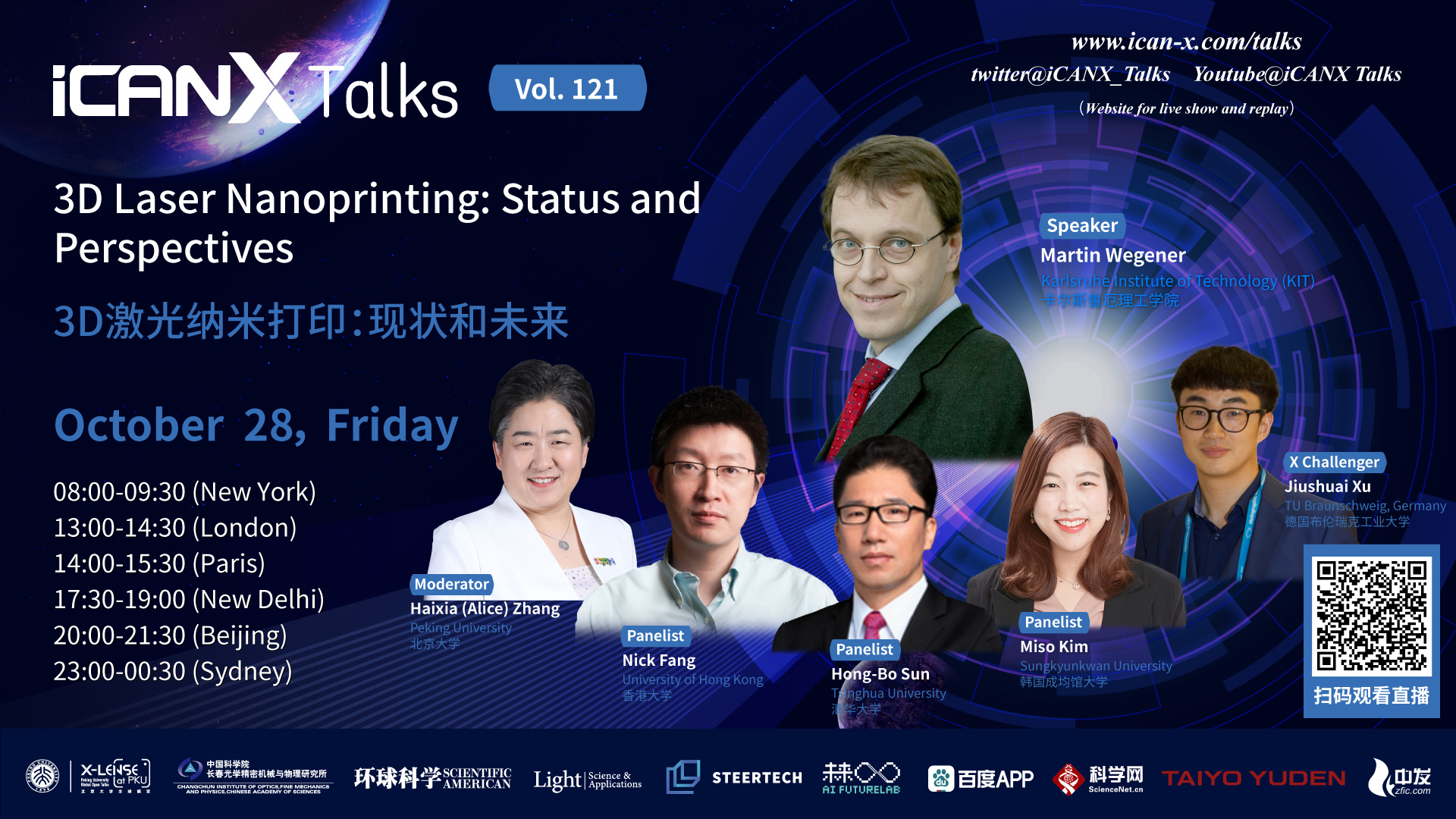博文
本周五iCANX直播:Martin Wegener 教授《3D激光纳米打印:现状和未来》
||
3D Laser Nanoprinting: Status and Perspectives
3D激光纳米打印:现状和未来

Martin Wegener
Institute of Applied Physics and Institute of Nanotechnology,
Karlsruhe Institute of Technology (KIT), 76128 Karlsruhe, Germany
应用物理研究所和纳米技术研究所,
卡尔斯鲁厄理工学院,卡尔斯鲁厄,德国
E-mail : martin.wegener@kit.edu
Website : https://www.3dmattermadetoorder.kit.edu/
ABSTRACT
Two-photon based 3D laser printing routinely allows for the making of complex three-dimensional sub-micrometer and nanometer structures and has become a mature, widespread, and commercially available technology. After briefly reviewing the basic principle and the state-of-the-art, I focus on recent progress in my group regarding the following aspects. (i) Replacing two-photon absorption by two-step absorption allows for using compact and inexpensive continuous-wave laser diodes instead of femtosecond lasers. This opens the door to democratizing focus-scanning 3D laser nanoprinting. Two-color two-step light-sheet 3D printing massively parallelizes the printing process. (ii) Still, the vast majority of printed structures are composed of only a single (polymeric) constituent material. I will describe several paths towards 3D multi-material architectures, including structures that show large actuation amplitudes using unfocused light as stimulus.
摘要: 因为实现了亚微米和纳米尺寸复杂三维结构的常规制备,双光子3D激光打印现已成为成熟且应用广泛的商业化技术手段。在今天的报告中,Prof. Wegener会先简要的阐述该技术的基本原理和前沿发展,然后详细介绍他带领的研究团队在该研究领域的一些突破性工作,主要包括:(1)用两步吸收代替双光子吸收,实现使用连续波激光二极管替代飞秒激光作为光源。基于双色两步光片的3D激光打印设备体积更小,更廉价,还可以实现大规模并行打印。(2)介绍几种利用多种材料复合构建的三维立体结构的途径,包括构建在非聚焦光源激励下大振幅响应的结构。解决当前绝大多数打印出的结构都只能由单一种类高分子材料构成的问题。
BIOGRAPHY
After completing his Diplom and PhD in physics at Johann Wolfgang Goethe-Universität Frankfurt (Germany) in 1986 and 1987, respectively, he spent two years as a postdoc at AT&T Bell Laboratories in Holmdel (U.S.A.). From 1990-1995 he was professor (C3) at Universität Dortmund (Germany), since 1995 he is professor (C4, later W3) at Institute of Applied Physics of Karlsruhe Institute of Technology (KIT). Since 2001 he has a joint appointment as department head at Institute of Nanotechnology (INT) of KIT, since 2016 he is one of three directors at INT. From 2001-2014 he was the coordinator of the DFG-Center for Functional Nanostructures (CFN) at KIT. Since 2018 he is spokesperson of the Cluster of Excellence 3D Matter Made to Order. His research interests comprise ultrafast optics, (extreme) nonlinear optics, optical laser lithography, photonic crystals, optical, mechanical, electronic, and thermodynamic metamaterials, as well as transformation physics. This research has led to various awards and honors, among which are the Alfried Krupp von Bohlen und Halbach Research Award 1993, the Baden-Württemberg Teaching Award 1998, the DFG Gottfried Wilhelm Leibniz Award 2000, the European Union René Descartes Prize 2005, the Baden-Württemberg Research Award 2005, the Carl Zeiss Research Award 2006, the Hector Research Award 2008, the SPIE Prism Award 2014 for the start-up company Nanoscribe GmbH, the Stifterverband Science Award – Erwin-Schrödinger Prize 2016, and the Technology Transfer Prize of the German Physical Society (DPG) 2018. In 2014, 2015, 2016, 2017, 2018, 2020, and 2021 Clarivate Analytics listed him as “Highly Cited Researcher” (top 1%). He is Member of Leopoldina, the German Academy of Sciences (since 2006), Member of acatech, the National Academy of Science and Engineering (since 2019), Member of the Hector Fellow Academy (since 2013, presently also President), Fellow of the Max Plack School of Photonics (since 2019), Fellow of the Optical Society of America (since 2008), and Honorary Professor at Huazhong University of Science & Technology, Wuhan, China (since 2014).
个人简介:
Martin Wegener分别于1986年和1987年在德国法兰克福大学获得物理学硕士和博士学位,之后前往美国贝尔实验室开始为期两年的博士后研究。之后的1990-1995年,Martin Wegener在德国多特蒙德大学担任副教授,自1995年起Martin Wegener在德国卡尔斯鲁厄理工学院(KIT)应用物理研究所担任教授。2001年起,Prof. Wegener兼任KIT纳米技术研究所系主任,并于2016年成为该研究所的三位所长之一。2001-2014, Prof. Wegener担任KIT德国科学基金会(DFG)功能纳米材料中心(CFN)的负责人。2018年起,Prof. Wegener担任精英集群“3D Matter Made to Order”的发言人。Prof. Wegener的研究方向主要包括,超快光学、(极端)非线性光学、光学激光光刻、光子晶体、光学、机械、电子和热力学超材料,以及变换物理。他杰出的科研工作让他获得了许多荣誉和表彰。比如,1993年the Alfried Krupp von Bohlen und Halbach Research Award, 1998年德国巴符州教学奖, 2000年the DFG Gottfried Wilhelm Leibniz Award (德国科学基金会-莱布尼茨奖), 2005年the European Union René Descartes Prize, 2005年德国巴符州科研奖, 2006年the Carl Zeiss Research Award, 2008年 the Hector Research Award, 2014年the SPIE Prism Award for the start-up company Nanoscribe GmbH, 2016 年the Stifterverband Science Award – Erwin-Schrödinger Prize(德国亥姆霍兹协会科学奖), 2018年德国物理学会技术成果转化奖。在2014-2018年和2020-2021年被科睿唯安(Clarivate Analytics)评为“高被引学者”(top 1%)。Prof. Wegener 2006年当选德国科学院院士(Leopoldina),2019年当选德国工程院院士(acatech)。此外,Prof. Wegener 2008年当选美国光学学会会士,2013年当选德国赫克托研究学院院士(现任院长),2019年当选德国马普所光子学院导师,2014年起任华中科技大学名誉教授。
https://blog.sciencenet.cn/blog-299-1361029.html
上一篇:张海霞│继续说说足球吧
下一篇:张海霞︱渐渐地我变成了自己最讨厌的样子